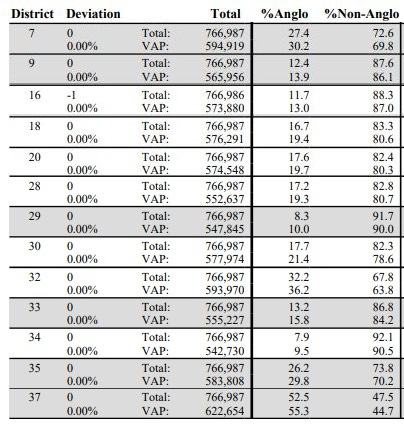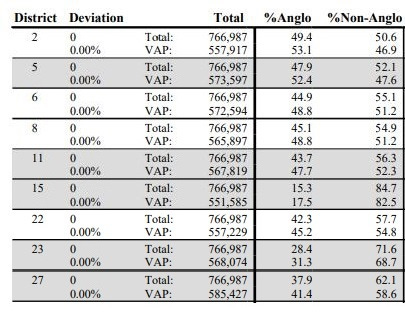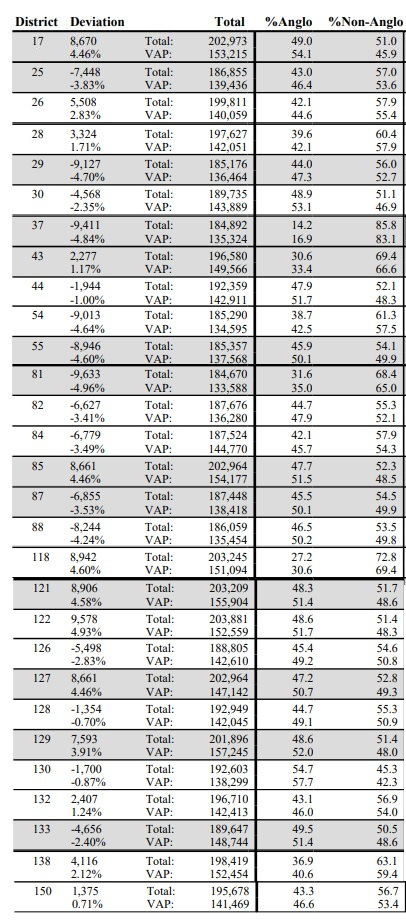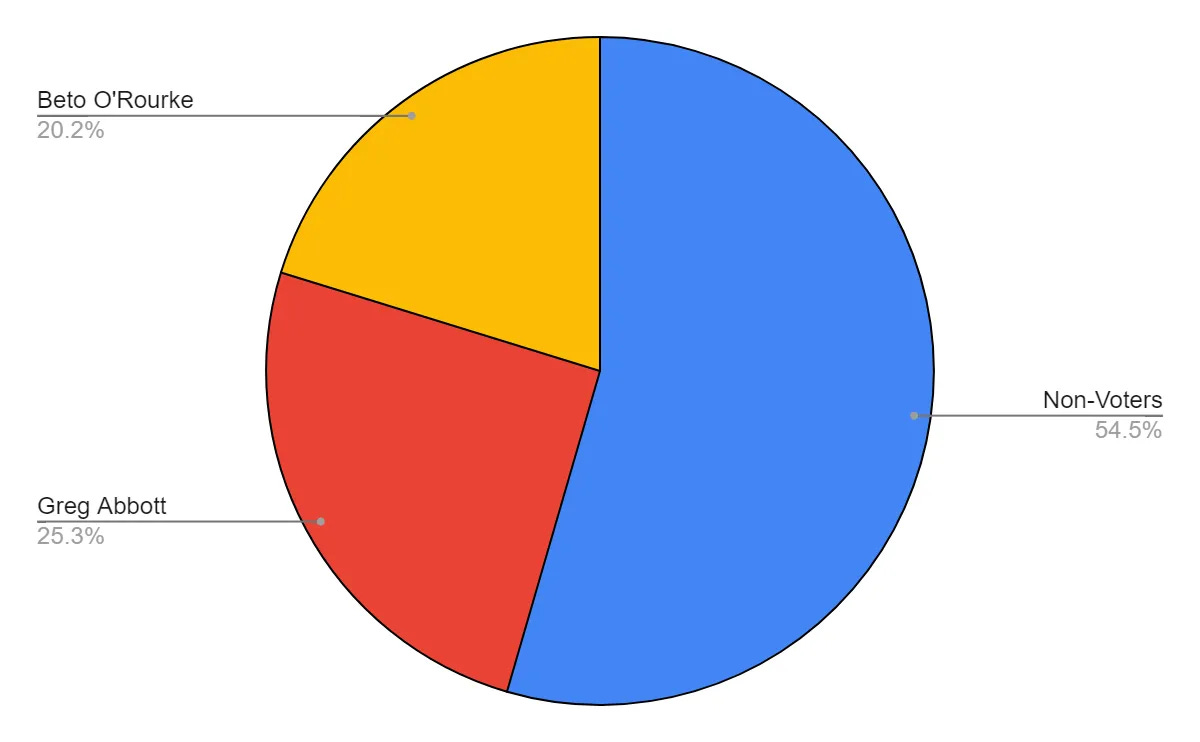Which Majority-Minority Districts Are Held By Republicans In Texas?
There's a lot of potential for political change in Texas, as majority-minority districts held by Republicans are becoming more competitive for Democrats.
Texas is not a red state. It’s a non-voting state. In the last election, 62% of the voter turnout was Anglo, even though white people only make up 38% of this state. In Texas, our government is run by white supremacists who thrive on their ability to hurt others. Despite what the GOP talking heads say, we have the data to back up how diverse our state is and how non-Anglos vote Democrat.
Here is the exit poll data from 2022 regarding racial demographics:
And in 2020:
While Republicans seem to get a boost of minority votes in 2022, compared to 2020, it was a non-presidential election year, and Democrats underperformed in Texas. You should expect to see the racial demographics in 2024 look more like they did in 2020 because millions more people will likely be voting.
Based on the last two elections in Texas, it’s clear that the majority of Anglo voters voted for Republicans, while the majority of voters of color voted for Democrats.
This is the biggest piece of the puzzle regarding the bluing of Texas.
Texas is now a majority-minority state, and with the majority voting for Democrats, it’s the critical ingredient to fixing this state. We first have to improve the low voter turnout, and then we’re set. That’s a tall order, but let’s talk about majority-minority districts.
Majority-minority districts with low voter turnout are paving the way for Republicans to strip away voting rights and pass bills to ban Black history or give you a 10-year prison sentence for having an undocumented immigrant in your car.
The truth is, we have so many majority-minority districts that if they saw a 75% voter turnout, they would easily flip.
Of course, there will always be outliers. Austin is reliably Democrat despite being a majority Anglo city. And Hispanic Republicans like Tony Gonzalez and Monica De La Cruz have won in border districts where voter turnout is usually around 30%. However, when looking at the bigger picture, we know that in Texas, Black, Hispanic, and Asian voters typically vote Democrat.
Democrats can win majority Anglo seats, and Republicans can win majority non-Anglo seats. There are a lot of other factors that come into play. I think it’s essential that we know which districts are held by white supremacist GOP members that we can take away. Candidates still have to work for votes, but they should be a lot easier to come by in these districts.
You have to understand Republicans gerrymandered these districts based on racial demographics.
Despite how they said it was to keep incumbents, what they did is apparent when looking at the maps. As a result, nearly all Democratic districts are majority-minority districts. And almost all Republican districts are majority Anglo.
When they drew the maps, they sliced up the pie as best as they could, but in many districts, they had to give Republicans only a 52% or 58% Ango-majority because there wasn’t anything left of the pie to split up. And as the Anglo population in Texas continues to shrink, these districts will become less Anglo and more blue.
To prove my point, here are all of the Congressional seats currently held by Democrats:
What do you notice? Except TX37, every singly Democratic seat in Texas is a majority-minority district. And TX37 is Lloyd Doggett’s seat, which encompasses Austin. Plug Doggett has been in office for decades and is well-liked.
So, without further ado—here are the majority-minority seats held by Republicans in Texas:
Congress.
There are nine Congressional seats, all held by Republicans, which are close to 50% non-Anglo or more. I’m predicting that all of these seats will be blue by 2030. How much sooner? It depends on how hard these Democratic candidates work to get out the vote (GoTV). More than likely, their Republican opponents will out-raise and outspend them, so they must work extra hard.
Who is on the ballot for these Congressional districts in 2024?
TX02:
Dan Crenshaw* (R)
Jameson Ellis (R)
Peter Filler (D)
TX05:
Lance Gooden* (R)
Ruth Torres (D)
TX06:
Jake Ellzey* (R)
James Buford (R)
Cliff Wiley (R)
John Love (D)
TX08:
Morgan Luttrell* (R)
Laura Jones (D)
TX15:
Monica De La Cruz* (R)
Vengela Churchill (R)
Michelle Vallejo (D)
John Villarreal Rigney (D)
TX22:
Troy Nehls* (R)
Wayne Raasch (D)
TX23:
Tony Gonzalez* (R)
Frank Lopez (R)
Brandon Herrera (R)
Victor Alvia (R)
Julie Clark (R)
Santos Limon (D)
Lee Bausinger (D)
TX27:
Michael Cloud* (R)
Luis Espindola (R)
Scott Mandel (R)
Chris Mapp (R)
Tanya Lloyd (D)
AJ Tristian (D)
State Senate.
Only a few majority-minority seats held by the Senate are held by Republicans up for re-election this year. Luckily for us, every Republican Senator is being opposed. This election, these Senate campaigns won’t be fought so much over demographics as they will over who participated in the corrupt acquittal of Ken Paxton.
Here are the majority-minority districts held by Republicans in the State Senate up this year:
And they have candidates, too:
SD07
Paul Bettencourt* (R)
Michael Pratt (R)
Nasir Malik (D)
Michelle Gwinn (D)
SD17
Joan Huffman* (R)
Kathy Cheng (D)
Other Senate seats are vulnerable in this election, like Donna Campbell in SD25 and Tan Parker in SD12. Campbell’s district would be one example of a district that can flip despite having an Anglo majority. Senate districts run four years, so a lot more of them will be up for election in 2026.
State House.
The disparity can be seen in the Texas House, where Republicans hold 29 majority-minority seats. You should expect many of these if not most, to go blue by 2030.
If these majority-minority districts knew how Republicans in the House were voting to ban Black history, prohibit diversity hires on college campuses, stop certain members of the AAPI community from buying property, and imprison people for having an undocumented passenger in their car, these districts would flip a lot sooner, rather than later.
Here are the majority-minority districts held by Republicans in the State House up this year:
And here are the ones who have Democratic challengers:
HD17:
Stan Gerdes* (R)
Tom Glass (R)
Desiree Venable (D)
HD25:
Cody Vasut* (R)
Jai Daggett (D)
HD26:
Jacey Jetton* (R)
Jessica Huang (R)
Matthew Morgan (R)
Daniel Lee (D)
HD28:
Gary Gates* (R)
Daniel Mathews (R)
Nelvin Adriatico (D)
Marty Rocha (D)
HD29:
Adrienne Bell (D)
Jeffrey Barry (R)
Alex Kamkar (R)
Trent Perez (R)
Edgar Pacheco Jr. (R)
HD30:
Jeff Bauknight (R)
AJ Louderback (R)
Bret Baldwin (R)
Vanessa Hicks-Callaway (R)
Stephanie Bassham (D)
HD37:
Janie Lopez* (R)
Ruben Cortez Jr. (D)
Alex Dominguez (D)
Jonathan Garcia (D)
Carol Lynn Sanchez (D)
HD43:
J. M. Lozano* (R)
Mariana Casarez (D)
HD44:
John Keumpel* (R)
David Freimarck (R)
Greg Switzer (R)
Alan Schoolcraft (R)
Eric Norman (D)
HD54:
Brad Buckley* (R)
Dawn Richardson (D)
HD55:
Hugh Shine* (R)
Davis Ford (R)
Hillary Hickland (R)
Jorge Estrada (R)
Jennifer Lee (D)
HD82:
Tom Craddick* (R)
Steven Schafersman (D)
HD84:
Carl Tepper* (R)
Noah Lopez (D)
HD87:
Jesse Quakenbush (R)
Robert Beyea (R)
Cindi Bulla (R)
Caroline Fairly (R)
Timothy Gassaway (D)
HD118:
John Lujan* (R)
Carlos Quezada (D)
HD121:
Steve Allison* (R)
Michael Champion (R)
Marc Lahood (R)
Shekhar Sinha (D)
Laurel Swift (D)
HD126:
Sam Harless* (R)
Sarah Smith (D)
HD127:
Charles Cunningham* (R)
John Lehr (D)
HD128:
Briscoe Cain* (R)
Bianca Garcia (R)
Chuck Crews (D)
HD129:
Dennis Paul* (R)
Doug Peterson (D)
HD130:
Tom Oliverson* (R)
Henry Arturo (D)
Brett Robinson (D)
HD138:
Lacey Hull* (R)
Jared Woodfill (R)
HD150:
Valoree Swanson* (R)
23 of the 29 majority-minority districts are being challenged by Democratic challengers. Now, all they have to do is overcome being outspent and focus on their opponent’s racist voting record, and they can flip their seats (ideally).
A reminder: the only reason Texas isn’t already blue.
We’ve got a long way to go, but we know what’s wrong, and many great people are out there trying to fix it.
The shifting demographics in these majority-minority districts present unique opportunities for Democrats to make transformative changes. Candidates in these districts must connect with their communities and address their specific concerns and needs.
As Texas continues to evolve demographically, it’s clear that the future of its political identity is in the hands of its diverse population. The journey towards a more representative Texas government is long, but with increased engagement and awareness, the path towards a more inclusive political sphere seems not just possible but inevitable.
LoneStarLeft’s Newsletter is a reader-supported publication. To receive new posts and support my work, consider becoming a free or paid subscriber.











